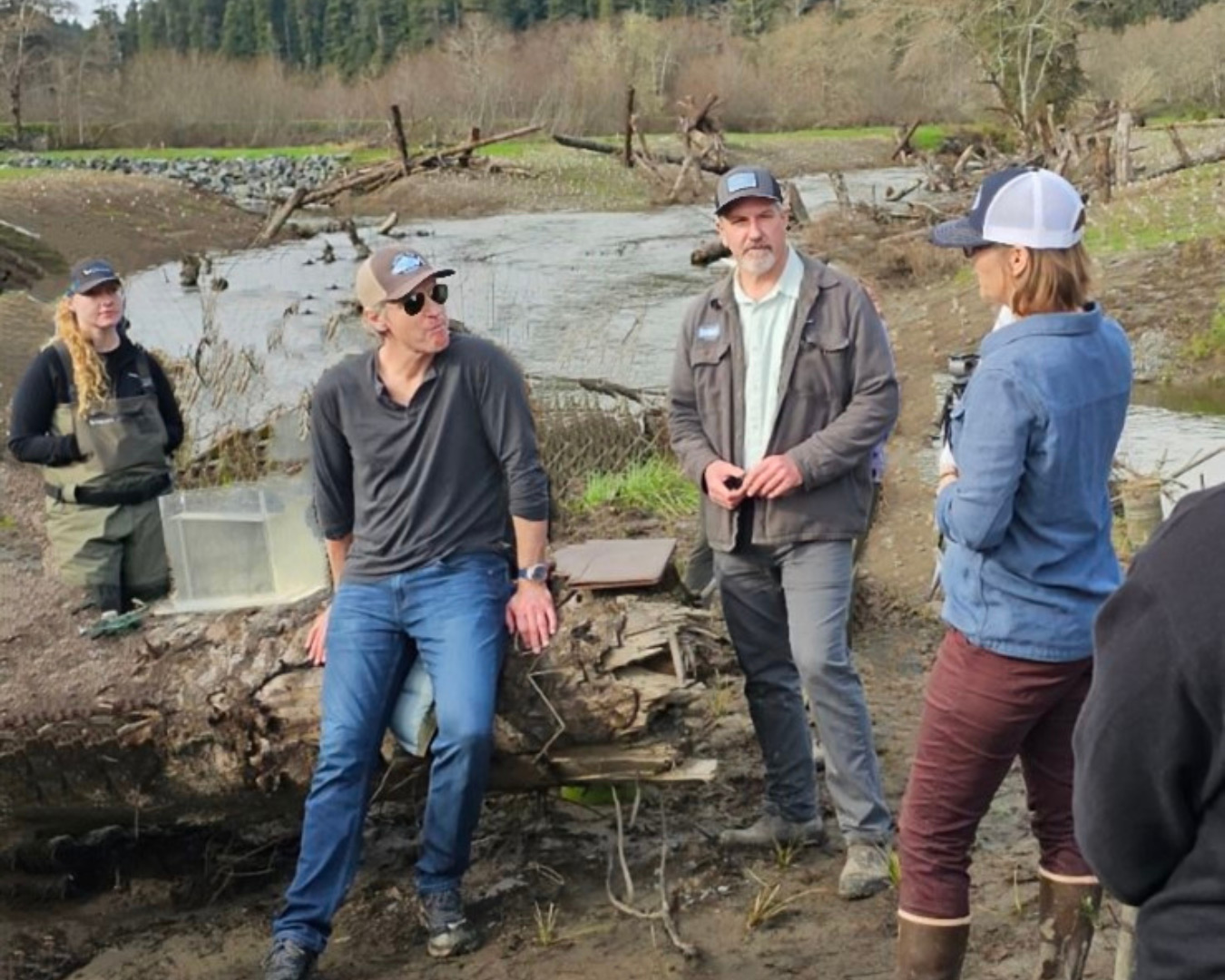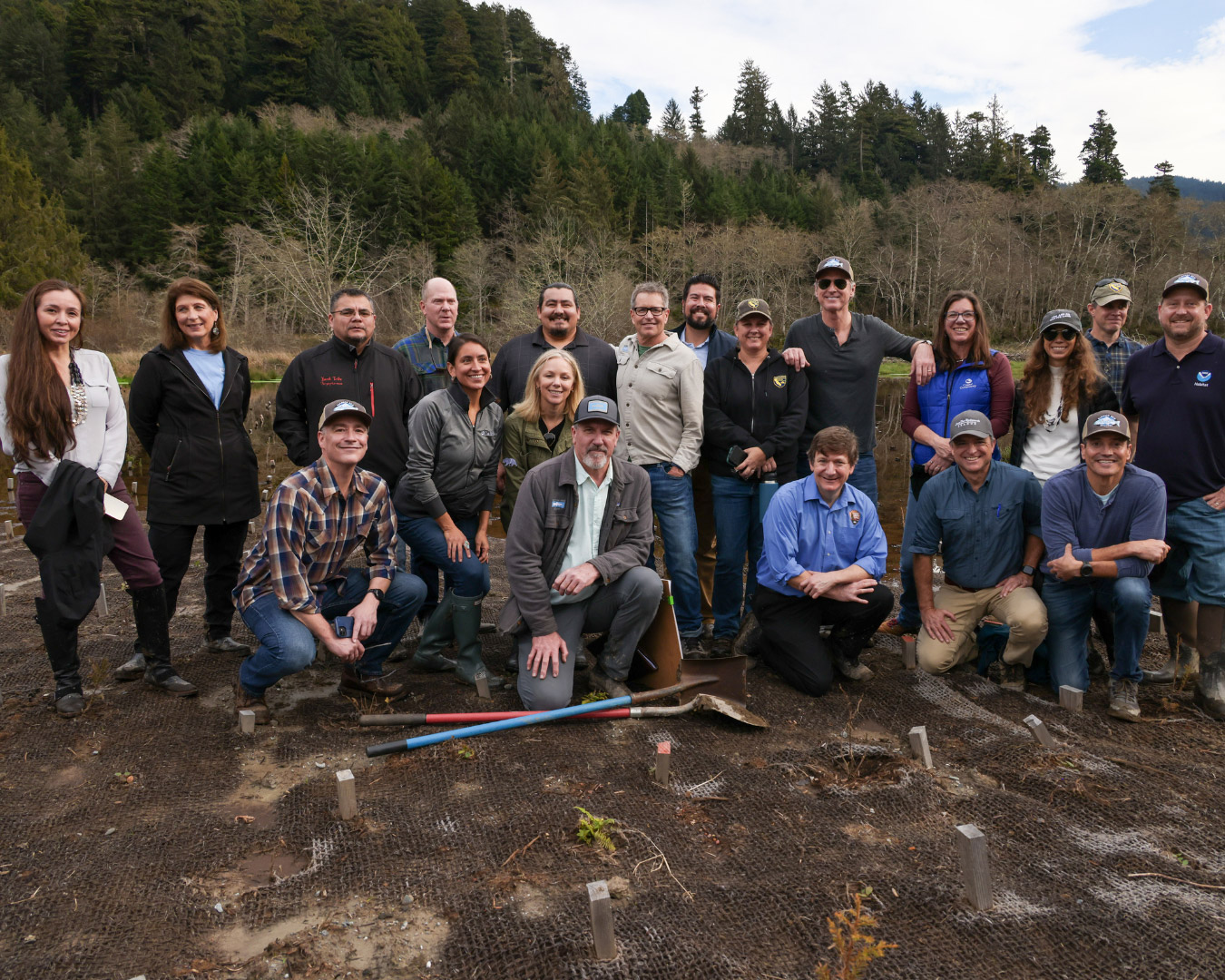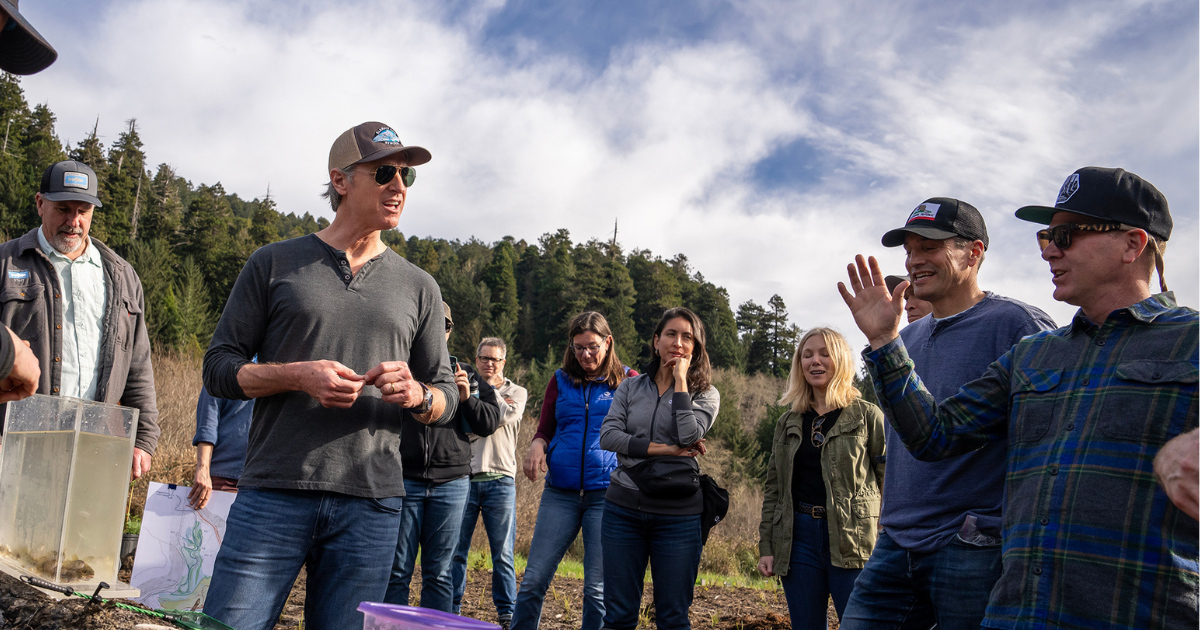Governor Newsom Tours CalTrout Projects and Releases New Salmon Strategy
Yesterday, January 29, 2024, CalTrout and our partners had the honor of showing California Governor Gavin Newsom and his cabinet secretaries around the sites of two of our collaborative restoration projects on the North Coast at Prairie Creek and the Elk River. The Governor’s visit coincided with his administration’s announcement of a new Salmon Strategy, an imperative step to address the urgent crisis our native fish are facing.
For over 50 years, CalTrout has been working to improve the fate of salmon and trout - culturally, ecologically, critically threatened, and economically important species - in the face of a changing climate. Recovery is possible if we continue to invest in landscape-scale actions such as dam removal and floodplain restoration. CalTrout works across the state to restore the ecological function of the watershed habitats on which our native fish depend for growth and survival. We also know that this work will require further investment in the best available science, planning, and collaborative community building. We are pleased to see that the Governor's plan includes many of these key actions and initiatives that will improve the status of salmon in California.
Redgie Collins, CalTrout’s Legal and Policy Director, was thrilled to review the plan this morning. “We are excited to see the overlap between CalTrout's priorities and the Newsom Administration's Salmon Strategy and we look forward to funding and implementing these efforts with the Governor’s support and leadership.”
“The Governor’s strategy brings in many of the elements we think are effective to bring back salmon populations. Restoring habitat, removing fish passage barriers, and investing in technology and science are crucial to ensure these fish are around for future generations,” said California Trout Executive Director Curtis Knight. “We don’t have a moment to waste, and this approach, built on partnerships with tribes and many others, indicates the right level of urgency to address the crisis these native fish are facing.”
Thank you to California Natural Resources Secretary Wade Crowfoot and Director of California Department of Fish and Wildlife Chuck Bonham for joining us in the field as well.


Read our full statement on the Governor's visit and the release of the Salmon Strategy:
FOR IMMEDIATE RELEASE
January 30, 2024
Contact:
Elizabeth Till - 773.405.4176 - etill@caltrout.org
Governor Newsom Tours North Coast Salmon Recovery Projects, Announces New Salmon Recovery Initiative
Leading freshwater conservation organization California Trout spearheading both projects
Eureka, California – California Trout (“CalTrout”), the state’s leading freshwater conservation organization, welcomed Governor Gavin Newsom to tour two of their restoration projects in Humboldt County on Monday. The Governor’s visit coincided with his administration’s announcement of a new Salmon Strategy developed to improve the fate of this culturally, ecologically, critically threatened, and economically important species in the face of a changing climate.
The two projects exemplify the work CalTrout does statewide to improve the health of watersheds, improve water quality, and restore populations of native salmon and trout. On the Elk River, a tributary to Humboldt Bay, CalTrout has completed years of planning and design work and is seeking implementation funding to restore longstanding water quality and habitat degradation. With the proposed transformative restoration actions, the Elk River can be a prime coho salmon stronghold on the north coast. And on Prairie Creek, at the gateway to Redwood National and State Parks, CalTrout is currently restoring a former mill site that has been reconfigured to reconnect floodplain and off-channel habitat to improve conditions for salmon and steelhead, and provide public access to the nearby redwood parks.
“By working with Tribal nations, community members, and close project partners like the Yurok Tribe and their Fisheries Department and Construction Corporation, Save the Redwoods League, and State and Federal agencies, we are completing several major projects to restore North Coast rivers as a stronghold for native fish in the state,” noted Darren Mierau, CalTrout Program Director in the North Coast region. “We’re pleased to see the Governor’s plan provides support for removing obsolete barriers like Scott and Cape Horn Dams that block migratory fish from the Eel River’s headwaters as well as for restoring spawning and rearing habitat. These actions are critical and urgent in light of climate change.”
Salmon and steelhead play an important role in tying together inland and marine ecosystems, helping to transfer nutrients between the ocean and rivers. Many species rely on salmon for food and key nutrients, making the slow-motion collapse of West Coast salmon a catastrophic loss for entire food webs. Salmon also provide essential nutrition and cultural benefits for tribes throughout the region, and recovering salmon and steelhead to self-sustaining levels is a tribal justice issue. Due to extremely low salmon populations, recreational and commercial salmon fishing was closed in most areas in 2023 creating economic hardship for coastal communities.
A report released by CalTrout in 2017 in partnership with UC Davis’ , Center for Watershed Sciences found that 74% of California’s native salmon, steelhead, and trout species are likely to be extinct within a century or less if present trends continue. But recovering diverse salmonid populations throughout California is possible if we invest in landscape-scale actions, such as dam removal and floodplain restoration, that restore the ecological function of the watershed habitats on which our native fish depend for the growth and survival. A return to abundance will also require further investment in the best available science, planning, and collaborative community building needed to durably execute those actions. CalTrout is pleased to see the Governor's plan include many key initiatives that will improve the status of salmon in California including:
- Remove Barriers and Modernize Infrastructure for Salmon Migration – CalTrout has identified six dams in the state that no longer serve their original purpose and where removal makes economic, social, and environmental sense. The Governor's plan pledges support for removing Scott and Cape Horn Dams on the Eel River and Rindge and Matilija Dams and for restoring the watersheds where these dams are located.
- Investments in technology and management systems - In 2023, the Governor signed AB809 (Bennett), which codified the California Monitoring Plan. The bill which was sponsored by the California Salmon and Steelhead Coalition – where CalTrout is a partner – tracks the population status of salmon in the state. Additional investments in monitoring, science, and planning can help to ensure the greatest benefit, confirm outcomes from restoration, and keep policymakers and the public well-informed of progress.
- Protect Water Flows and Water Quality in Key Rivers at the Right Times to Support Salmon – Caltrout is working with farmers, Tribal nations, and partners across the state to improve water management important to fish and people. CalTrout is a co-sponsor of AB1272 (Wood) which empowers the State Water Board to plan and prepare for drought conditions in North Coast streams to protect California’s iconic salmon runs in times of water shortage.
“The Governor’s strategy brings in many of the elements we think are effective to bring back salmon populations. Restoring habitat, removing fish passage barriers, and investing in technology and science are what’s needed to ensure these fish are around for future generations,” said California Trout Executive Director Curtis Knight. “We don’t have a moment to waste, and this approach, built on partnerships with tribes, agencies, and many others, indicates the right level of urgency to address the crisis these native fish are facing.”





